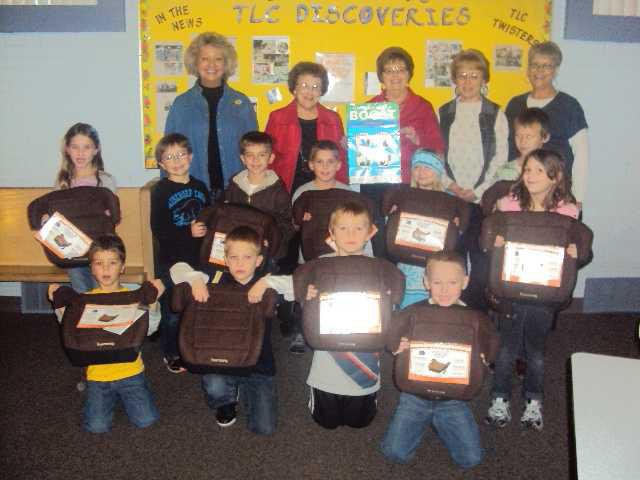In the past month, the Great Bend Pilot Club has donated cash for car seat detector kits and car seats to the Great Bend High School Family and Consumer Science Class, as well as a load of free booster seats to TLC Discoveries after school program. It’s part of an effort to help reduce the number of brain injuries to children through proper use of car seats.
When children aren’t properly restrained, they are more susceptible to injury, even in a minor crash.
“The Great Bend Pilot Club wants parents to understand that even a mild bump or blow to the head can cause a concussion, and that concussions don’t always involve a loss of consciousness,” said Rhonda Knudson, president. The club strives to support brain research, brain safety, and assistance to those with brain-related disorders.
Booster Seats for ages 4-7
Sharon King and Sharon Mauler, the project chairpeople, made a recent delivery of booster seats to TLC Discoveries after school program.
“It is through our educational awareness efforts that we want to underscore the importance of preventing head injuries in the first place -- through consistent use of booster seats and seatbelts,” Mrs. King said.
Further Mrs. Mauler, commented, “This is especially important for younger children, whose brains appear to be vulnerable to lasting damage.”
Knudson cites a study by The University of California Los Angeles (UCLA) which found that children with mild brain injuries typically showed subtle effects that resolved with time. But, with more severe injuries, however, the risk of lingering problems was significantly greater. For children who suffer moderate to severe brain injuries, the long- term outlook is not as good, the review found.
In the months after their injury, children with moderate brain injuries typically lagged behind their peers in certain intellectual measures, like brain processing speed, memory, and problem solving. Two or more years later, the children generally showed some improvements, but often still trailed other children their age. For children with severe brain injuries, the review found that the gaps with their peers often worsened over time.
By offering free booster seats, the club hopes to help parents to properly restrain young children who have outgrown forward facing car seats, but are not yet large enough to fit the adult seat belt restraint system in most vehicles.
Monitoring “babies”
In January, the GB Pilot club gifted $935 to USD 428 earmarked for the purchase of detection kits and car seats to support the Family and Consumer Science Classes at Great Bend High School.
Jane Heeke, FACS teacher, uses baby simulators in her Human Growth and Development class. “The babies cry, and students need to determine how to comfort it within two minutes, or minutes of crying time begin to be recorded,” she said.
Heeke can also determine how hot or how cold the baby is, and for how long. Students may check the baby into “daycare” at the beginning of the school day, but must be at Heeke’s class promptly at 3 p.m. when the babies are turned back on.
“The monitors are going to improve on what we are already doing,” she said. “With the new car seats, I can show the students how to properly restrain the baby.”
Heeke says even with 11 babies, she has more than 100 students go through the excercise each year, and the equipment receives lots of use. The updated car seats will replace older generation seats.
The district was able to purchase 11 pairs of equipment. The detectors record when a child is properly restrained, as well as how long it remain in the seat. In addition to being able to see if the baby is safe while driving, Heeke can tell if it was taken out of the seat for feeding and for comforting, and if it was left in the car alone.
When babies are left in a sealed car on a moderately warm day in the 60s, temperatures inside can rise up to 110 degrees, according to the National Highway and Traffic Safety Administration. That’s high enough to cause brain damage or death in an infant. And it can happen fast. The first 70 percent of temperature change occurs in the first 20 minutes.
While Kansas does not have a specific law addressing unattended children in cars, prosecutors can criminally charge adults under existing child endangerment laws.
The Pilot club felt that providing the tools would open the door for students in the class to understand the enormity of the job of parenting and the importance of being ready for the responsibility, Knudson said.
“We felt this is a perfect fit for the Pilot club and our aims since it first gives the needed tools to the youth,” she said.
Students can then become aware of some of the effects of improper or non-existent restraint. There is the possibility of a condition commonly called “shaken baby syndrome.” When an infant or toddler is shaken, the brain bounces back and forth against the skull. This can cause bruising of the brain, swelling, pressure or bleeding on the brain. In severe cases it can cause large veins along the outside of the brain to tear, increasing pressure, which can lead to permanent brain damage or death. Shaking an infant or small child may cause other injuries too, such as damage to the neck, spine, and eyes.
“It teaches the student that a baby needs to be properly placed in the vehicle and securely fastened in the approved car seat, especially to protect the baby’s brain,” Knudson said.
Pilot Club spreads word about car seat safety
Club donates cash, seats to area groups





